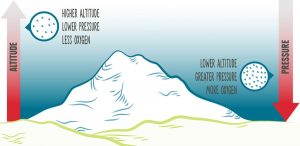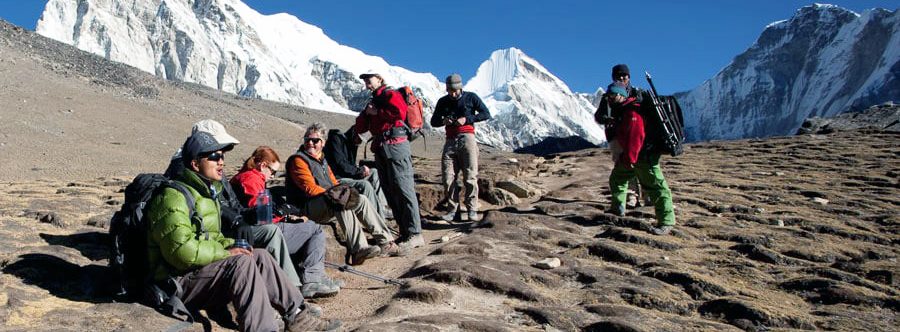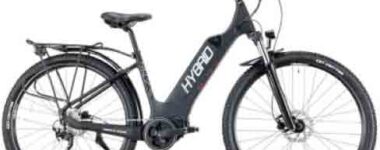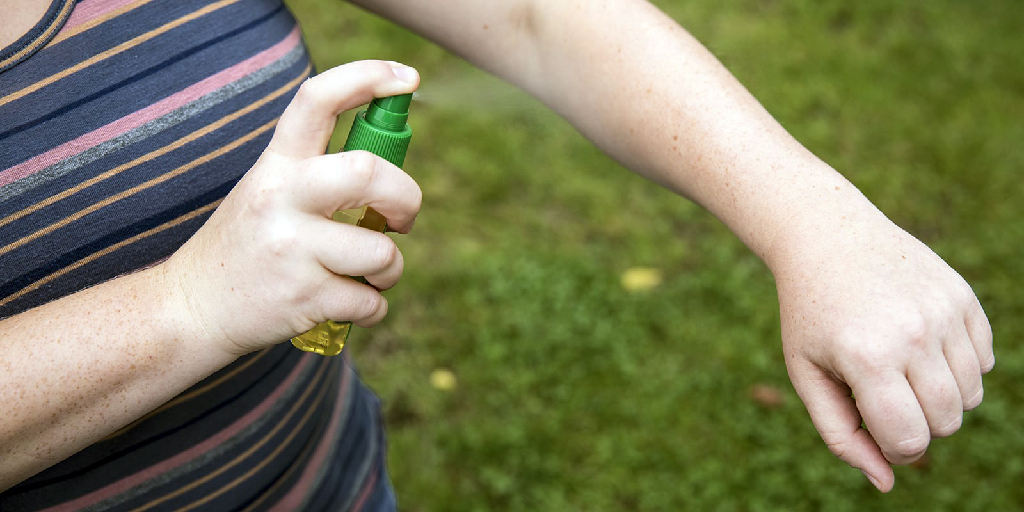Latest News
Share this post:
You don’t have to be climbing the south face of Annapurna to encounter altitude sickness. Anyone who is hiking, trekking or simply hanging out at several thousand feet above sea level can be stricken.
Altitude illnesses come in three variations, the last two of which can turn fatal:
-
-
-
-
- Acute Mountain Sickness (AMS) is the mildest, most common version.
- High-Altitude Cerebral Edema (HACE) is when the brain begins to swell.
- High-Altitude Pulmonary Edema (HAPE) is when the lungs begin to fill with fluid.
-
-
-
For a deep dive into these topics, consult a medical professional or take a course taught by a certified instructor.
-
-
-
-
- Causes
- Symptoms and treatments
- Prevention
-
-
-
Causes of Altitude Sickness
When you feel symptoms of altitude sickness, your body is reacting to getting less oxygen out of the “thinner” air that exists at higher altitudes than your body is used to. So why is the air thinner?

Air pressure and oxygen levels: Air pressure depends on the weight of air above you, which is why higher altitudes have lower air pressures. This lower pressure means that the number of all molecules making up each lungful of air, including oxygen molecules, is reduced.
Acclimatisation and the role of your hometown: Often 8,000 feet is cited as the elevation where the reduction in oxygen intake can cause symptoms. Equally important is the altitude where you live, because your body has adapted to the level of oxygen available there.
So at that 8,000-foot elevation, a resident of a sea-level town like Miami will likely be afflicted more severely than someone who lives in the Mile High City, Denver. In addition, sea-level dwellers may experience symptoms at lower elevations.
Symptoms and Treatments of Altitude Sickness

Though symptoms and their progression vary, a single response—taking the person to a lower altitude—is the most effective treatment for all of these conditions. And the one response that’s guaranteed to make things worse is “toughing it out” by continuing your ascent.
Symptoms of Acute Mountain Sickness
Whether steady or throbbing, a headache is a telltale sign that you have AMS. Sufferers will also have one or more of these hangover-like symptoms:
-
-
-
-
- Nausea/vomiting
- Fatigue
- Lethargy
- Loss of appetite
- Difficulty sleeping
-
-
-
Treatment: The good news is that the body can cure this by itself. You have to give it sufficient time, though, to adapt to a higher altitude. Descend to the last elevation you slept at without feeling symptoms. Then rest until you feel better.
Symptoms of High-Altitude Cerebral Edema
HACE initially presents as a moderate to severe form of AMS. Clues that brain swelling has begun are confusion and impaired balance. Look for these signs:
-
-
-
-
- Cannot walk a straight line, heel to toe
- Cannot balance on one foot
-
-
-
Treatment: A person diagnosed with HACE needs to immediately be escorted to a lower altitude. Full resolution of symptoms simply from descending is unlikely, so you should be thinking about how to contact medical help as soon as HACE is suspected.
Symptoms of High-Altitude Pulmonary Edema
HAPE may or may not be preceded by AMS or HACE. Its initial symptoms are shortness of breath accompanied by a dry cough. Signs that the lungs are continuing to fill with fluid include:
-
-
-
-
- Shortness of breath becomes worse
- Unexpected fatigue and inability to exert oneself
- A wet, gurgly cough develops
-
-
-
Treatment: To prevent added stress on the lungs, a HAPE sufferer should be carried to a lower elevation immediately. Left untreated, HAPE can cause someone to collapse and die. Call a medical professional if symptoms persist.
Medications for Altitude Sickness
Over-the-counter remedies—ibuprofen, acetaminophen and aspirin—all help relieve the headache associated with AMS and HACE. It’s not uncommon for the headache to persist, though, after these medications are taken. In addition, the headache will usually resolve itself after you’ve descended and/or given your body time to adapt to the higher altitude.
Advanced Treatments for Altitude Sickness
Drugs like Diamox (Acetazolamide) and treatments like pure oxygen are beyond the scope of this article. To learn more about the realm of things a certified medical practitioner must oversee, consult with your doctor.
Prevention of Altitude Sickness

Not surprisingly, managing altitude and ascent is key to avoiding altitude sickness. If you do this effectively, your body can adjust its physiology to run on rarefied air.
Acclimatisation: It’s remarkable how well we can adapt to altitude, if we give our body time to do so. Your heart rate and breathing will speed up, and your blood will develop higher-than-normal amounts of red blood cells. The rest of your cells slowly change too, so that they use oxygen more efficiently.
If you give yourself at least two days to reach an 8,000- to 10,000-foot elevation, and then limit daily ascents to 1,000 feet, your body will have a better chance to adapt. Note, too, that it’s your sleeping altitude that’s key: You can climb higher in a given day as long as you come back down to a snoozing elevation that’s within this limit.
Everyone adapts at a different rate: You might be able to acclimatise more quickly than the above rule of thumb, or less quickly. Age, gender, race—even your level of fitness—don’t correlate conclusively with faster or slower adaptation rates. Take your time and listen to your body.


 Collecting and Propagating Seeds
Collecting and Propagating Seeds China on a Plate: The Flavours of a Nation (with a Spotlight on Sichuan)
China on a Plate: The Flavours of a Nation (with a Spotlight on Sichuan) Kinesiology Cross Patches
Kinesiology Cross Patches Camaraderie On a Walking Tour…
Camaraderie On a Walking Tour… How E-Biking Has Transformed Biking Tours
How E-Biking Has Transformed Biking Tours








